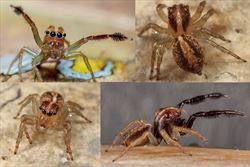
Examples of live Prostheclina
Illustrator (and ©) R. Whyte

Aspects of the general morphology of Prostheclina
Illustrators (and ©) B.J. Richardson (CSIRO), M. Zabka (diag,)

Palp morphology of Prostheclina
Illustrator (and ©) B.J. Richardson (CSIRO)

Epigyne morphology of Prostheclina pallida
Illustrator (and ©) B.J. Richardson (CSIRO)
Prostheclina Keyserling, 1882
Taxonomy
Prostheclina has seven Australian species, Prostheclina amplior, P. basilonesa, P. boreoaitha, P. boreoxantha, P. bulburin, P. eungella and P. pallida and undescribed spp. are also known (Whyte unpubl.) The genus is part of distinct group of Australian genera (Maddison et al 2008) related to the Old World genus Saitis (Zhang and Maddison 2015). Prostheclina is closely related to Barraina, Hypoblemum, Jotus, Maratus and Saratus. Further information on the genus in Australia can be found in Richardson and Żabka (2007, 2017) and Whyte and Anderson (2017).
Description
Prostheclina spp. are small to medium-sized spiders, ranging in body length from 3 to 7 mm. The head, viewed from above, is rather pear-shaped, widest behind the posterior lateral eyes. The cephalothorax is high, highest at the posterior lateral eyes. The abdomen is ovate. Chelicerae have a single (unident) retromarginal tooth and one or two promarginal teeth. The first pair of legs is longer and stronger than the others. The fourth pair of legs are longer than the third legs. Varying patterns of species-specific, sparse or thick brushes are found on the tibia and metatarsus of leg one and on the face and upper edge of the cephalothorax.
The male’s palp has a long, coiled embolus arising on the distal surface of the tegulum and forming an anti-clockwise full circle. The embolus is combined with an associated sclerite. The tegulum is longer than wide, with a large, wide, proximal lobe. The palpal tibia has a single, short, pointed apophysis.
The female has two, large, well-sclerotised epigynal atria with copulatory openings on the lateral edge. The insemination ducts travel antero-medially then posteriorly either side of the midline to pear-shaped spermathecae which are located adjacent to or overlapping the posterior medial edges of the atria.
Biology
Prostheclina spp. are found on foliage in tropical and temperate rainforests, in wet eucalypt forest, wet and dry woodlands and grassy areas. The distinctive colouring, markings and fringing on the first pair of legs and face, combined with only small differences in the copulatory organs, suggest that visual cues are important in species recognition.
Distribution
Prostheclina occurs widely across the wetter parts of eastern Australia from Queensland to Tasmania and South Australia. The inland edge of distributions roughly follows the 600 mm rainfall line.
References
Davies, V.T. & Żabka, M. 1989, Illustrated keys to the genera of jumping spiders (Araneae: Salticidae) in Australia. Memoirs of the Queensland Museum 27, 189-266.
Maddison, W.P., Bodner, M.R. & Needham, K.M. 2008. Salticid spider phylogeny revisited, with the discovery of a large Australian clade (Araneae: Salticidae). Zootaxa 1893, 49-64.
Richardson, B.J. & Żabka, M. 2007. A revision of the Australian jumping spider genus Prostheclina Keyserling, 1892 (Araneae: Salticidae). Records of the Australian Museum 59, 79-96.
Richardson, B.J. & Żabka, M. 2017. Salticidae. Arachnida: Araneomorphae. Canberra, Australian Faunal Directory. Australian Biological Resources Study, at https://biodiversity.org.au/afd/taxa/SALTICIDAE.
Zhang, Junxia & Maddison, W.P. 2015. Genera of euophryine jumping spiders (Araneae: Salticidae), with a combined molecular-morphological phylogeny. Zootaxa 3938: 1-147.
Whyte, R. and Anderson, G. 2017. A field guide to the spiders of Australia. Clayton: CSIRO Publishing 451pp.
* The information sheet should be read in the context of the associated diagrams and photographs. Diagrams explaining anatomical terms can be found in the ‘Salticidae’ pictures at the beginning of the list of genera.